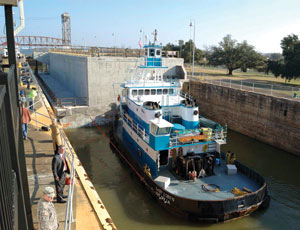By June 1, when the 2011 hurricane season starts, the U.S. Army Corps of Engineers and its industry and municipal partners will have delivered the bulk of a $14.6-billion program to provide New Orleans and surrounding parishes with what they say will be the best flood protection ever. The 350-mile Greater New Orleans Hurricane and Storm Damage Risk Reduction System consists of reinforced levees, concrete floodwalls, surge barriers, pump stations and floodgates that will provide 100-year protections—defenses against a storm with a 1% chance of occurring in any given year.

Above: Deep Soil Mixing
Contractors are performing a deepsoil- mixing project (left) to stabilize soil enough to widen and heighten a 5.3-mile stretch of earthen levees in eastern New Orleans. It is the world�s largest deep-soil-mixing project.
Top: Building A Barrier
A tugboat pushes a 5,700-ton concrete barge gate through the Inner Harbor Navigation Canal locks in New Orleans. The 150-ft-wide gate is one of three such structures in the 1.8-mile-long surge barrier.
Since the ravages of Hurricane Katrina in 2005, the Corps and its team have pushed to deliver the system safely and quickly by using a mix of innovative contracting, engineering, design and technology. The storm surge that devastated the city when the hurricane hit caused levee failures and widespread overtopping, and also demonstrated to the world that the flood-protection system was one in name only.
“After Hurricane Katrina, firm administration commitment and quick congressional action enabled the Corps to initially repair and restore 220 miles of the system and put in interim closure structures at the city's three outfall drainage canals,” says Michael F. Park, the Corps official who, as chief of Task Force Hope, is overseeing the flood protection program. Congress continued its support in supplemental funding authorizations to deliver the largest civil works program in Corps history.
Unparalleled
The overall $14.6-billion fully funded program is significantly larger than the agency's national annual civil works program, which is typically about $5.5 billion, with only $2 billion going to construction. Comparatively, in the past six years the Corps district in New Orleans has awarded more than 300 construction contracts, with a value of more than $9 billion.
“It is absolutely phenomenal the amount of work accomplished in this time frame,” Park says. “We have achieved this historic and unparalleled feat by working collaboratively with our partners in federal, state and local governments, levee authorities, levee boards and industry.” For this milestone, the regional editors of Engineering News-Record have named the Army Corps of Engineers team in New Orleans as Owner of the Year for Texas & Louisiana.
In 2010 alone, the Corps awarded 71 contracts worth $1.8 billion for work on the storm system. In 2011, it anticipates awarding 31 contracts worth an estimated $1.06 billion. “We plan to award another 46 contracts through calendar year 2015,” says Nancy Allen, spokeswoman for the Corps Hurricane Protection Office in New Orleans. Although the 100–year protections will be in place by June 1, construction of additional features will continue.
Early Involvement
Non-traditional contracting was one tool the Corps used to expedite the program, Park says. The $1.3-billion Inner Harbor Navigation Canal Surge Barrier, built by Shaw Environmental, Baton Rouge, La., on the eastern flank of New Orleans, is the largest design-build civil works project in agency history. The Corps previously used design-build methods for building structures, but not on civil works. The approach made it possible for construction to begin on the 1.8-mile barrier while design was ongoing. Shaw broke ground in May 2009. The floodwall portion of the barrier will be complete by June 1, at which time its three gated structures are expected to be operable.
The Corps also used “early contractor involvement,” a variation of construction management-at-risk, to speed project delivery. Bill Heathcott, program manager in Atlanta for Archer Western Contractors Ltd., says the ECI approach has been “a phenomenal process and a huge success” for his firm and its joint venture partner, Alberici Enterprises, St. Louis. The companies are working on a $300-million deep-soil-mixing project that will stabilize the soil enough to widen and heighten a 5.3-mile stretch of earthen levees in eastern New Orleans, he says.
“I was impressed with ECI because it gave us the ability to start work before design was completed, and it allowed constructibility and ingenuity to impact the final design, which reduced the overall cost,” Heathcott says. “We were brought in when the plans were something less than 35%, and we worked together through 100% [of the] design. We were all on the same page and communicating well.” He adds that the project could not have been brought in with this schedule “without extreme communication early on, and that couldn't have been done without ECI.”
On March 10, the second 750-ton leaf of the largest sector gate in the U.S. was placed using early contractor involvement on the $1-billion Gulf intracoastal waterway's west closure complex. The project, which includes a 19,140-cu-ft-per-second pump station and 225-ft-wide sector gate, began in August 2009 and is about 67% complete. It would still be in the early phases of construction if ECI had not been used, says an official of Gulf Intracoastal Constructors, a joint venture of Kiewit Corp., Omaha, Neb., and Traylor Bros. Inc., Evansville, Ind.
Archer Western also holds a $114.9-million fixed-price contract on a project using geotextile fabric and wick drains to speed soil consolidation on a 7.54-mile stretch of earthen levees in eastern New Orleans. “Even on the firm-fixed-price job, it was clear that the Corps was committed to the schedule,” Heathcott says. Managers “worked to resolve issues that could slow the job down and were innovative with solutions,” he adds.
Sense Of Urgency
The enormity and pace of the Corps program has generated other innovative technical and project management approaches. Park cites the use of 30 value engineering studies for the project. Among the techniques adopted were hydraulic press-in pile drivers to reduce noise, pile-load tests in advance of awards to determine pile lengths, work-flow indicator systems to track progress and advanced materials purchases. “We purchased steel piles in bulk when the market price was low,” he says. “That saved the mission more than $50 million on its first contract alone.”
Heathcott, who has spent his entire career in public works, says the Corps of Engineers' sense of commitment was evident. “From a public works perspective, the owner has to have a real desire, a sense of urgency to deliver a fast-track project,” he says. “The Corps did everything possible to deliver this quality product safely, with response to issues and negotiation that were handled in fairness to all parties.”
About 60% of contracts awarded to date for work on the flood risk-reduction system were to Louisiana-based companies, including more than $2.25 billion to small and disadvantaged businesses, officials point out. The Corps estimates that the work created about 4,000 jobs.
“Had we not had the Corps work, the area would have been in bad trouble,” says Jonathan Kernion, president of Cycle Construction Co., Kenner, La.
Along with funding, Corps work for local contractors had declined in the years prior to Hurricane Katrina. “Katrina hits, [the agency] gets all this funding, and they're on fire,” Kernion says. “It was definitely a boost to the industry.” He estimates that since Katrina, about 75% of his business is Corps-related work. “I've worked for [the agency] for 30 years, and I'd rather work for the Corps than any other owner,” he says.
For fiscal 2010, the Corps Hurricane Protection Office, one of three agency divisions performing work in New Orleans, reported 2.6 million contractor man-hours worked with a lost-time injury frequency rate of .30. About 2.3 million contractor man-hours have been worked to date in fiscal 2011, with an injury frequency rate of just .09, officials point out. “The Corps has zero tolerance for poor safety habits,” Kernion says.
Contractors are still weighing the long-term effects of new approaches the Corps used in the massive levee-building program. “This is my first time working with the Corps,” says Mike McClellan, construction manager for the Archer Western-Alberici joint venture. “I think the Corps is an excellent owner and certainly holds you to a high standard on quality and safety. But at the end of the day, they are all about getting the work done on time and for a reasonable price. The Corps is one of the best owners I have worked for.”



Post a comment to this article
Report Abusive Comment